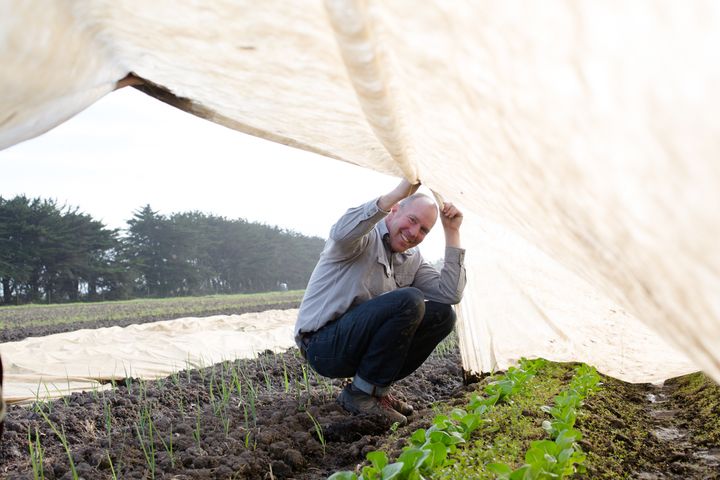
Jered Lawson check'n in with the crops, Pie Ranch
Guest writer: Lizzy Elliott
“Part of the consequences of a food system rife with anonymity is that you end up not knowing the stories and people behind the food. And unfortunately most of that story is rather problematic - industrial agriculture’s exploitation of animals, people, and the land…But we think the story could be really different, and we’re committed to telling that story…” – Jered Lawson
Driving down Highway 1 on the California coast, vast green hills on my left and the endless blue water to my right, we arrive at Pie Ranch, an educational farm in Pescadero, California. Driving up the dusty road past the goat barn, I feel a familiar sense of comfort, reminded of my time spent working here as a farm intern six years ago. During my time at Pie Ranch, I harvested endless strawberries for pies, milked goats, learned to humanely slaughter chickens, and the studied the art of laying drip irrigation. Having known and admired Jered Lawson - Pie Ranch co-founder and co-director - for almost a decade, I was excited to sit down to interview him about his exciting new projects – CSA 2.0 and Farm Kit - and the impact of his food justice work on the community.
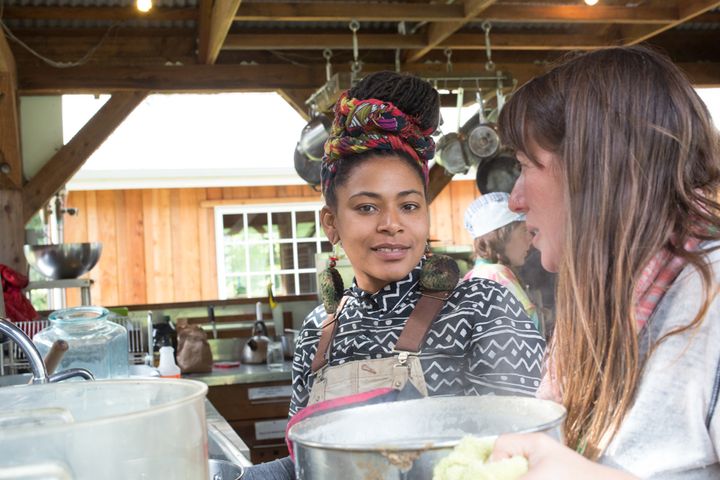
Students in the outdoor test kitchen, Pie Ranch
About 10 years ago, Jered Lawson and his wife Nancy Vail created Pie Ranch, a small, non-profit, food-justice-certified educational farm with the intent to “create a more equitable food system.” Having both had life changing experiences in nature growing up, Nancy and Jered wanted their farm to be an educational space where the next generation could have moments of learning and discovery. Jered explains that Pie Ranch is rooted in social change goals, to bring “fresh food closer to home for more of the community.” The logic model for their work is simple. Jered explains, “first, through youth and public education programming, we build the demand for healthy, just food. Next, we train the next generation of farmers through an apprenticeship program to meet that new demand with an increased supply of healthy, sustainable food. And finally, throughout this work, we foster an urban-rural partnership, develop markets, increase access to capital, land, and resources to be able to foster the conditions for this supply and demand to grow.”
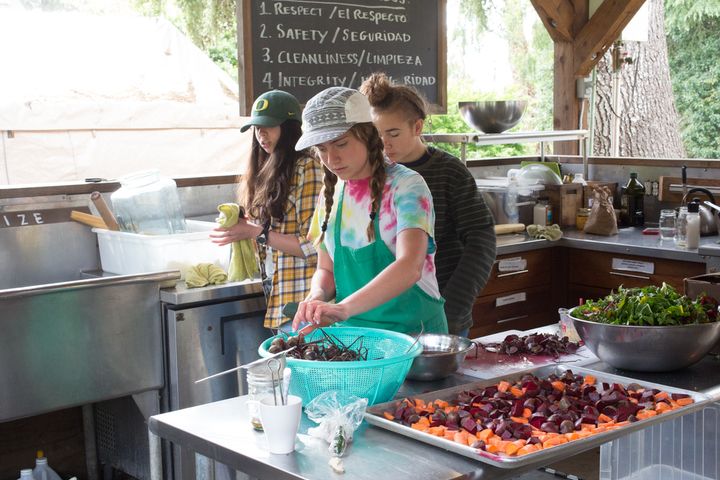
Students cook’n up a storm in the outdoor kitchen
Pie Ranch is indeed known for its youth education programming, as well as its monthly community work day and barn dances, and of course for it’s fresh produce and pies sold at the farm stand off Highway 1. Throughout our visit to Pie Ranch, we could hear kids laughing – holding baby goats, learning how to roast root vegetables, and rolling out dough for homemade pies. The large, well-outfitted outdoor kitchen, complete with a pizza oven, is a key feature and hub on the farm. There, Jered explains, “students learn to cook and prepare everything we grow – fruits, vegetables, legumes, and grains.” While visiting the farm, students camp in tents in the meadow near blooming cherry blossom trees and a fire pit gathering circle. About 6,000 people come through Pie Ranch each year and experience some part of the farm. 2,000 of that 6,000 are youth, many of them from nearby urban areas. These students learn to grow and cook healthy food to feed themselves and their communities.

Student camping grounds, Pie Ranch
After establishing Pie Ranch’s successful education and apprenticeship programming, Jered began focusing his efforts on scaling their production and distribution practices to a more replicable model of commercial viability. Jered and his team created “CSA 2.0,” an initiative to leverage the purchasing power of institutions and create more economic stability for local farmers. “Adults, not just kids, need to learn where their food is coming from.”
For those unfamiliar to a CSA, Community Supported Agriculture (CSA) program involves a joint partnership between local farmers and individual consumers wherein members (consumers) agree to financially commit up front to a farm in return for a steady supply of local produce throughout the year. This system offers farmers economic security while they grow crops, and offers consumers fresh seasonal tasty food grown on nearby farms they know and trust.

Nitrogen rich cover crops recently tilled in preparation of spring planting
Jered and I gently pull the row-cover cloth off the beds to check on the growing little gems lettuces beneath. Jered tells me that in a CSA 2.0 model, “institutions act like individual consumers. Farms will commit to crops – like this crop of little gems – destined for dining facilities on corporate and college campuses.” With an increased cultural value placed on food, particularly in the Bay Area, Jered wants to see institutions as the responsible consumers who frequent farmers markets to buy local organic produce. He hopes eventually companies will act in the same conscious, committed way as a household would to a local farm through a CSA. So far, Jered has partnered with big companies like Google, educational institutions like Stanford University, and startups like Airbnb to test out this model which he is now taking baby steps to introduce to their public school partners.
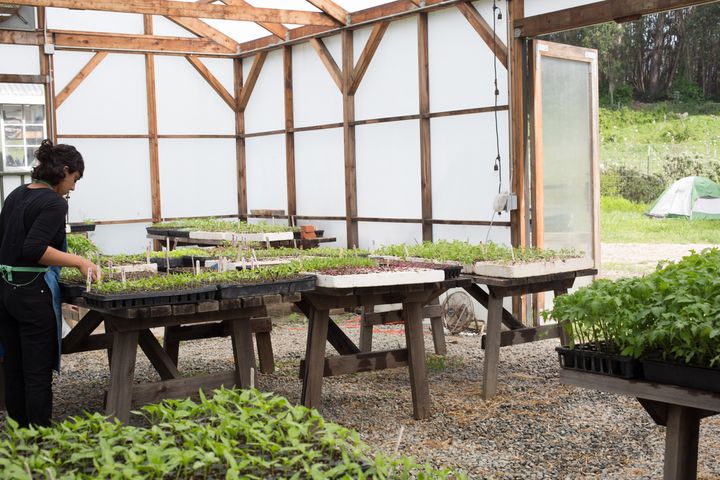
Student tents just outside the propagation room
When they first met, Jered and Nancy were very involved in CSA farming happening at the UC Santa Cruz School Center for Agroecology and Sustainable Food Systems. With this knowledge and their goals in mind, 4 years ago they began leasing a new plot of 75 acres of farmland across the highway from Pie Ranch for CSA 2.0 food production. They divided the land in half: one half for growing fresh produce, the other for grazing cows and chickens to naturally restore the soil. Now, in their fourth growing season, they’ll rotate at the end of year - growing hardy greens and cool coastal vegetables where the soil has been restored.
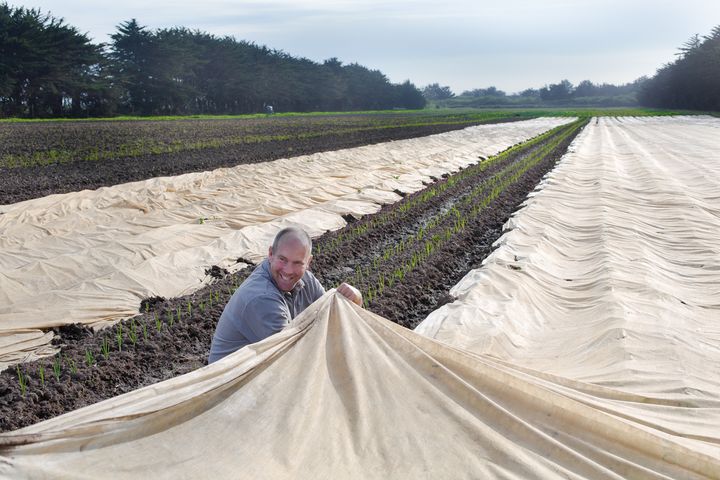
Reams of cover cloth protect vulnerable seedlings from frost and pests.... and keeps the warmth of the soil overnight
Jered shares CSA 2.0’s many benefits with me while we walk along rows of fava beans. “It allows us take steward the land in the best way as well as providing a fair and just working conditions for our growing number of employees. It also allows for less food waste altogether.” Cafeterias can immediately absorb the local supply, particularly during peak of harvest when abundance can quickly turn to food waste. “By creating personal relationships between buyer and grower, we create a direct line of communication about a specific crop, which cuts down on a lot of the waste that happens in anonymous wholesale markets. These institutional dining facilities are themselves nodes of aggregation of individual households.” Jered believes this program can build more direct, mutually-beneficial relationships between farms, institutions, and households – to be able to “support each other in achieving peak sustainability, performance, and health.”
Jered is also working on the beta version of a project called Farm Kit, a twist on the popular meal kit model. Requiring a bit more engagement than a normal meal kit, but more curation than a regular CSA, Farm Kit offers local seasonal farm products designed around specific meals, with all the ingredients available through the kit. While the project is still being tested, it has promising qualities that make CSAs more accessible to everyone.
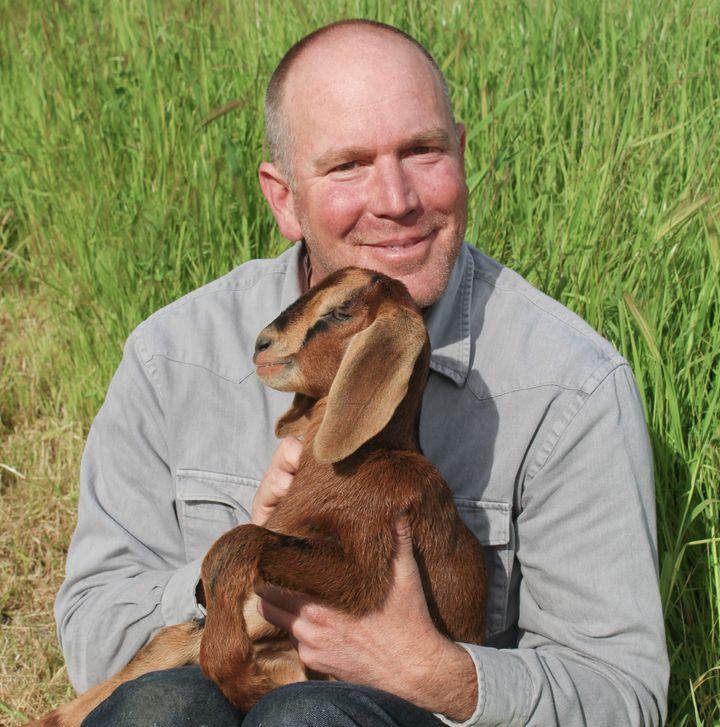
Jered and friend
Jered’s innovative ideas and practical implementation inspires me to dream big and put my own food justice visions into action. His devotion to educating and mobilizing the next generation of consumers, farmers, and chefs gives me optimism during a time of immense uncertainty and change. Looking out over the acres of small but growing vegetables, Jered said, “These days, with all the challenges we are facing, it is hard to know what to do. But this is actually something we can do to make the world a better place.”
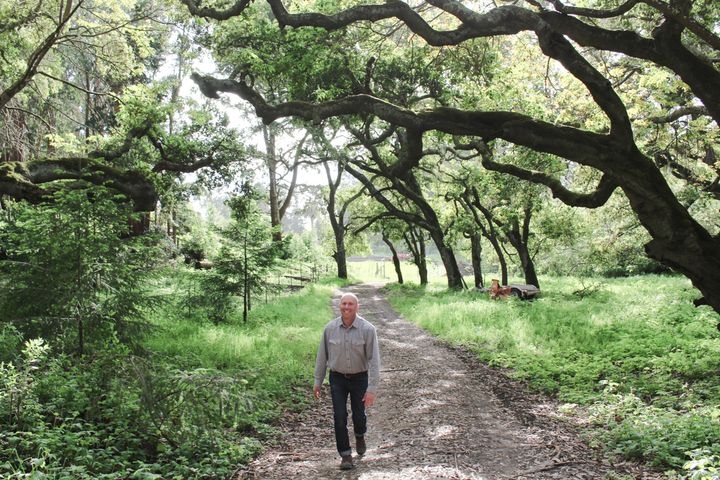
Jered at Pie Ranch
Lizzy Elliott bio:
Lizzy Elliott is a Northern California native and Wesleyan University graduate passionate about food justice and environmental stewardship. When not photographing her friends, food, and surroundings, Lizzy can be found singing, backpacking, gardening, or roasting root veggies. She believes in the power of visual storytelling to spur the social and environmental change we need to see in our world.

